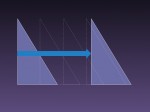Archives → Projector Resource
Number of the Day (junior)
Just added to MathsStarters: Number of the Day (junior) is for Stage 2/3 students (Years 3 to 6) covering:
-
represent numbers of up to four digits using objects, words, numerals and digital displays
-
identify the number before and after a given two-, three- or four-digit number
-
count forwards and backwards by tens and hundreds on and off the decade
-
arrange numbers of up to four digits in ascending and descending order
-
use place value to partition numbers of up to four digits
-
round numbers to the nearest ten, hundred or thousand
[MA2-4NA; ACMNA052, ACMNA053. Reference: NSW Syllabus for the Australian Curriculum, Mathematics K-10 Syllabus]
Relative Frequency - Investigation
Probability is one of those topics where it's best to "see it".
Preparing to Engage, Enhance and Extend
I am presenting twice in September about how I use technology to engage, enhance and extend in my teaching.
New on MathsStarters… Bingo!
I reckon Maths Bingo is a great starter, ender or in-betweener…
Car Racing
Playing with the kids’ toys on the weekend, I came across this car and became interested by the relationship between pulling it back and how far it would travel.
Was it a linear relationship or something else?
Smartie Statistics
Looking around, there are lots of activities for collecting and analysing data using small boxes of Smarties. Here is my version.
Substitution Spider
Having made a Tables Spider this other day, I realised that I made myself a template for creating all sorts of “spiders”.
Tables Spider
In 2007, I wrote about a resource, a Number Spider, that I used as a lesson starter.
Chocolate Bar Graphs
Some chocolate discussion starters for looking at bar graphs: a series of chocolate bar graphs.
Introducing Probability
This is an amusing video to introduce probability… some of my Year 8s found it hilarious.
Classroom Icons
Having found this tip on elearnr.org Doug Belshaw’s blog about using PowerPoint:
Find graphics that represent things you do frequently in lessons (perhaps from clipart) and always use these when doing a similar activity. For example, a pen writing for when it’s time to start work or two people talking for discussion/group work. These help reinforce good habits and aid classroom management.
I went looking for some nice graphics to use.
Perimeter of curved shapes
This week, Year 9 were looking at finding the perimeter of shapes that include curves (parts of a circle).
Digital Media - Capacity
With laptops rolling out shortly and projectors appearing in some classrooms, we should be thinking about collecting digital media for use as stimulus or investigation material. So, the other day when filling up my young daughter’s bottles, I took some pictures.
Dice
I wanted to play a multiplication bingo type game with a class the other day, so I grabbed two 10 sided dice (apparently you don’t need to call a single dice a “die” anymore) out of the cupboard. Then I thought… hey I have a projector and a laptop.
Isometric Drawing
When starting “Volume” with Year 8, we start by looking at cubic units and isometric drawings. This year, with an interactive whiteboard (although, these resources are also suited for use with just a projector or in a computer lab), I was able to use a couple of excellent online resources.
Transformations
 Here’s a PowerPoint file I made to quickly review transformations before getting into congruency.
Here’s a PowerPoint file I made to quickly review transformations before getting into congruency.
Parts of a Circle
I need to learn to use GeoGebra because it looks like a fantastic app, it’s free and shortly our students will have their own netbooks, itching to use them. I find the best way to learn new software is to do something with it that you need.
End of term activities 4 - The Game of Hex
The last week of term begins next week…
New Subscribe to the …
MathsLinksemail newsletter
Get updates…
About
Simon Job — eleventh year of teaching maths in a public high school in Western Sydney, Australia.
MathsClass is about teaching and learning in a maths classroom. more→
Archive
Elsewhere
 @simonjob
@simonjob
updates via  @mathslinks
@mathslinks
Recently read/found.
Being a Vector is not Mutually Exclusive – Ringo Mok
maths vectorsInstagram
Gcf howie_hua maths
